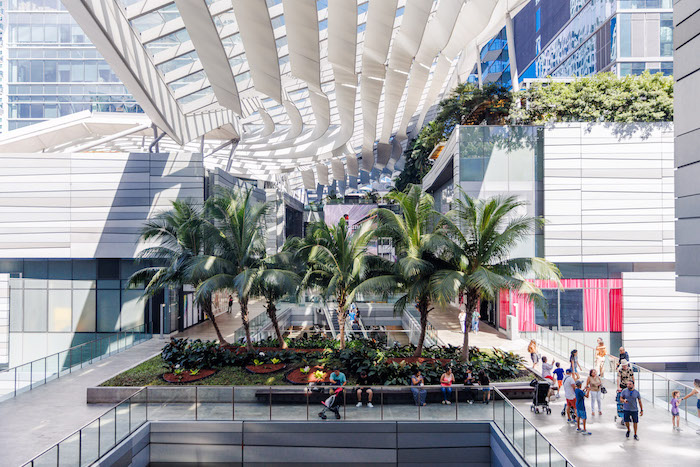Our comprehensive climate risk assessment process identifies the key risks posed by climate change to our business operations, and the business opportunities that may arise from new climatic conditions.
Physical Risk Assessment
We conduct asset-level modelling of both the acute and chronic physical risks associated with various climate scenarios. These are presented in selected timeframes from the immediate term to the distant future – 2030 (short term), 2050 (medium term) and 2100 (long term). The process also includes detailed asset-level assessments that evaluate individual buildings’ sensitivity and adaptive capacity to the potential effects of the identified climate risks.
The most recent assessment identified that, overall, there are low to moderate levels of risk for flooding, heat stress, water stress, and extreme wind for our global portfolio in all assessed climate scenarios. These risk levels are attributed to the relatively robust adaptive capacity and mitigation measures we have integrated into our buildings.
It also identified short- and mid-term measures for individual buildings to mitigate risks and build resilience across our portfolios. Examples include:
- Upgrading flood protection measures and alert systems
- Improving chiller efficiency
- Regularly inspecting glass façades
- Installing smart monitoring systems
The relevant resilience measures will also be incorporated into the planning and design stages of new developments to ensure our assets will continue to be resilient under different future climate scenarios.
After the release of AR6 in 2022, we immediately began to update our climate models to incorporate the latest available climate science.We also perform deep-dive hazard modelling for our projects in Xi’an and Sanya. The results will be analysed to generate climate-related parameters and design concepts for projects to help design teams communicate and channel climate-related considerations into their designs.
Assessment of Transition Risks and Opportunities
In 2022, we performed a comprehensive review of global, national and local government policies, including Hong Kong’s Climate Action Plan 2050 and regulatory, market and technological trends based on different climate scenarios involved in the global transition to a low-carbon economy.
We identified a number of risk and opportunity drivers that may have a financial impact on our business under three different climate scenarios: the “Net Zero Scenario” (1.5°C); the “Paris Consistent Scenario” (2°C); and the “Hot House World Scenario” (3°C). The drivers include tightened building energy codes and guidelines, increased market demand for green and energy-efficient properties, and climate-resilient properties.
Based on the analysis, our current business and sustainability strategies will allow us to effectively manage the identified transition risks and capture the identified opportunities during the transition to a low-carbon economy. These strategies include:
- 1.5°C-aligned science-based targets to drive long-term carbon reduction.
- Investment in, and development of, certified green buildings with best-in-class energy efficiency and climate resilience.
- Investment in renewable energy measures throughout our portfolio.
- Wide application of innovative green technologies.
- Commitment to green financing.
- Engaging our supply chain, tenants and other relevant stakeholders in climate resilience and sustainability initiatives.
We also conducted a quantitative assessment of the potential financial impacts of key identified transition risks and opportunities that will inform our risk management and strategic planning.
Heat Map Showing the Estimated Annual Impact of Climate-related Risks and Opportunities under Different Climate Scenarios in 2030
Risks | Opportunities | |||||
|---|---|---|---|---|---|---|
Risk / Opportunity Driver | 1.5°C Scenario | 2°C Scenario | 3°C Scenario | 1.5°C Scenario | 2°C Scenario | 3°C Scenario |
Tightened building energy codes and guidelines | ||||||
Introduction of carbon pricing in operating markets | ||||||
More stringent public disclosure requirements | ||||||
Increased market demand for climate resilient properties | ||||||
Increased market demand for green and energy efficient properties | ||||||
Increased tenant demand for energy efficiency and data transparency | ||||||
Growing investor demand for green and low-carbon finance and investment | ||||||
Potential increase in insurance premiums | ||||||
Increased exposure to reputation and litigation risks | ||||||
Greater adoption of low-carbon construction materials | ||||||
Utility supply and cost | ||||||
Increased adoption of green and low-carbon technology | ||||||
Increased adoption of renewable energy | ||||||
Risk Level
Lower risk
Moderate risk
Higher risk
Lower opportunity
Moderate opportunity
Higher opportunity
Not applicable
Risk / Opportunity Driver | Tightened building energy codes and guidelines | Introduction of carbon pricing in operating markets | More stringent public disclosure requirements | Increased market demand for climate resilient properties | Increased market demand for green and energy efficient properties | Increased tenant demand for energy efficiency and data transparency | Growing investor demand for green and low-carbon finance and investment | Potential increase in insurance premiums | Increased exposure to reputation and litigation risks | Greater adoption of low-carbon construction materials | Utility supply and cost | Increased adoption of green and low-carbon technology | Increased adoption of renewable energy | |
|---|---|---|---|---|---|---|---|---|---|---|---|---|---|---|
Risks | 1.5°C Scenario | |||||||||||||
2°C Scenario | ||||||||||||||
3°C Scenario | ||||||||||||||
Opportunities | 1.5°C Scenario | |||||||||||||
2°C Scenario | ||||||||||||||
3°C Scenario | ||||||||||||||
Risk Level
Lower risk
Moderate risk
Higher risk
Lower opportunity
Moderate opportunity
Higher opportunity
Not applicable
With the support of a risk management consultant, in 2023, we undertook a pioneering study to quantify the financial impact of climate-related transition risks and the opportunities associated with a transition to a low-carbon economy. Twelve facilitated workshops were held, involving over 50 colleagues across different business units. These workshops evaluated the risks and opportunities related to policies and regulations, markets, reputation and liability, supply chains, and technologies under three future climate scenarios (1.5°C, 2°C and 3°C). The findings included:
- Our energy-efficient green buildings may significantly impact tenant retention, with an estimated value of up to HKD421 million27. In order to determine the financial impact, we utilised the rental premium as suggested in JLL’s “The Value of Sustainability” report published in November 2022. By considering our Hong Kong office gross rental income for that year, we estimated the potential value derived from the rental premium associated with our sustainable buildings. This underscores the tangible benefits and value proposition of our sustainable properties, further strengthening our market position and enhancing tenant satisfaction and retention.
- By 2030, HKD105 million in projected savings on potential carbon taxes may be realised by achieving the Company’s 2030 SBT-aligned emission targets.28
- By 2030, projected annual savings of up to HKD12 million may be realised through green financing instruments such as sustainability-linked loans.29
For more information, please refer to our Climate-related Financial Disclosures.
27 | The JLL report entitled “The Value of Sustainability” (published in November 2022) suggests a 7% rental premium on green building-certified Grade A office space. The estimated revenue is calculated based on 2022 Hong Kong office gross rental income on an attributable basis. |
28 | Compared to the business-as-usual carbon emissions level. A carbon tax of USD103/tCO2 is expected to be introduced in Greater China, as suggested by the Network for Greening the Financial System’s Scenario Explorer. |
29 | It is estimated that for every HKD10 billion of sustainability-linked loans, interest cost savings of up to five basis points (i.e. HKD5 million) can be anticipated, based on a figure of HKD30 billion in borrowings in 2030, 80% of which is from green financing (SD 2030 KPI). |
See More In
NaN / 3



